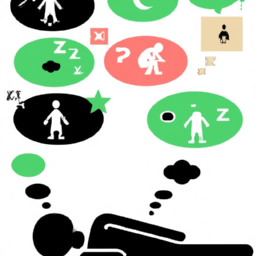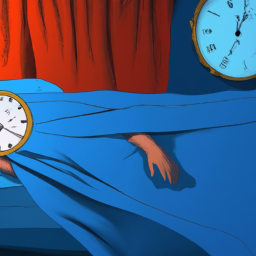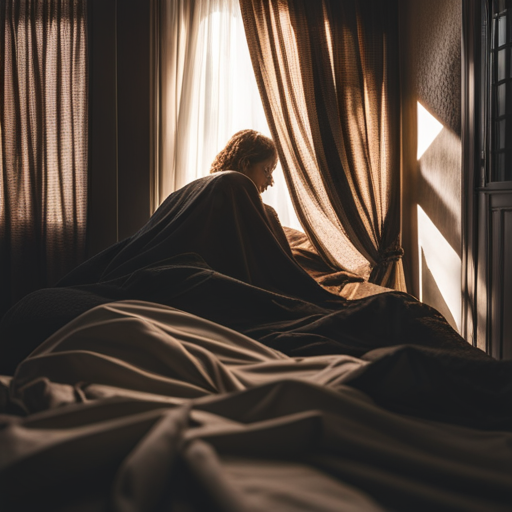Dream Meaning
Why Do I Have Bad Dreams When I Sleep On My Back

As an individual who appreciates a restful sleep, my interest has been piqued by the relationship between the position in which I sleep and how it impacts my dream state. I’ve noticed that I tend to experience more intense and disturbing nightmares when I rest on my back. This observation led me to question the reasons behind this phenomena and whether there were any steps I could take to enhance the quality of my dreams.
After some research, it turns out that sleeping position can indeed affect our dreams. There are several factors at play, including breathing patterns, sleep paralysis, and other physiological responses that vary depending on how we position ourselves in bed.
In this article, we’ll explore the relationship between sleeping position and dreaming, with a particular focus on why sleeping on your back may lead to bad dreams. We’ll also discuss practical tips for improving your sleep quality and overall well-being.
Key Takeaways
- Sleeping position can affect the quality and content of dreams, with sleeping on your back linked to more vivid and intense nightmares.
- Sleeping on your back can also increase the likelihood of experiencing sleep paralysis and may cause snoring and even sleep apnea due to airway obstruction.
- Coping mechanisms for bad dreams and sleep paralysis include practicing good sleep hygiene, relaxation techniques, and seeking professional help from a therapist or counselor.
- Other factors, such as anxiety, trauma, medication side effects, and even certain foods, can also contribute to nightmares, and treatment options for sleep disorders and nightmares include therapy, medication, and lifestyle changes.
Overview of Sleeping Positions and Dreaming
Sleeping habits can have a significant impact on the content and frequency of dreams. One’s sleeping position can influence what one dreams about while asleep. For instance, sleeping on your back is often linked to more vivid and intense nightmares.
Dream interpretation experts suggest that sleeping in this position may increase the likelihood of experiencing sleep paralysis or other related phenomena. This occurs when an individual wakes up from a dream but finds themselves unable to move their body. The experience can be quite frightening and may contribute to the negative nature of certain dreams.
Overall, there’s a clear link between sleeping positions and dreaming, which is important to keep in mind when trying to achieve restful sleep each night.
The Link Between Sleeping Position and Dreams
When I lie flat on my bed, my body’s position can influence the vividness and content of my REM cycle experiences. According to relationship research, sleeping positions can significantly affect the quality of sleep we get.
Sleeping on your back is said to increase the likelihood of experiencing bad dreams or nightmares compared to other sleeping positions like sleeping on your stomach or side. This is because when you lie on your back, you are more likely to experience sleep paralysis which makes it easier for vivid and often frightening dreams to occur.
Cultural differences also play a role in how sleeping positions affect dreaming. In some cultures, sleeping on one’s back is associated with death and therefore avoided at all costs. However, this belief does not have any scientific backing but may affect an individual’s mindset towards their sleep position choice.
Overall, while there may be a link between sleeping on one’s back and bad dreams or nightmares, further studies need to be conducted to confirm this relationship before making conclusive statements about its effects on our sleep quality.
Transitioning into the subsequent section about how sleeping on your back affects breathing, it’s important to note that our sleep position also affects other aspects of our health beyond just our dreams.
How Does Sleeping on Your Back Affect Breathing?
I’ve always been curious about how my sleeping position affects my breathing, especially when I sleep on my back.
It turns out that the anatomy of the throat plays a big role in this. When we lie on our backs, gravity pulls down on our throat muscles and narrows our airway, making it harder to breathe properly.
This can lead to snoring and even more serious conditions like sleep apnea.
Anatomy of the Throat and Breathing
You might notice that your breathing can be affected when lying on your back due to the anatomical structure of your throat. The throat is made up of several muscles, tissues, and cartilage that work together to allow air to flow in and out of the body. However, when you lie on your back, gravity pulls down on these structures, causing them to collapse inward and obstruct the airway. This leads to breathing difficulties during sleep.
Airway obstruction can cause a range of problems such as snoring or even sleep apnea. Snoring occurs when there’s a partial blockage of airflow through the nose and mouth. Sleep apnea is a more severe form of airway obstruction where there are complete pauses in breathing during sleep that can last for seconds or even minutes.
If you experience any difficulty breathing while sleeping on your back, it may be helpful to try sleeping on your side instead. In the next section, we’ll explore how sleeping position affects sleep apnea and snoring further.
Sleep Apnea and Snoring
Airway obstruction can result in snoring or sleep apnea, which are both conditions that affect breathing during sleep.
Sleep apnea is a disorder where a person’s breathing repeatedly stops and starts while they sleep because the throat muscles relax and block the airway.
Snoring is caused by vibrations of the tissues at the back of the throat due to partial obstruction of the airway.
If you suffer from snoring or sleep apnea, there are solutions available to help alleviate symptoms. One option is wearing a continuous positive airway pressure (CPAP) mask, which delivers pressurized air to keep your airways open throughout the night.
Another solution is using oral appliances designed to reposition your jaw and tongue to prevent blockage of your airway.
Additionally, lifestyle changes such as losing weight, avoiding alcohol and sedatives before bedtime, and sleeping on your side can also be beneficial snoring remedies.
The Relationship Between Breathing and Dreaming
As the lungs expand and contract with each breath, the mind’s ability to conjure up vivid dreams while sleeping on one’s back also increases. It is believed that the relationship between breathing and dreaming is complex, as changes in respiration can influence the type and intensity of dreams experienced.
Breathing techniques, such as deep belly breathing and mindfulness practices, may help reduce stress levels and promote relaxation, leading to a better night’s sleep with fewer bad dreams. However, it is important to note that bad dreams are not solely caused by sleeping on one’s back or breathing patterns.
Other factors, such as anxiety, trauma, medication side effects, and even certain foods, can contribute to nightmares. Additionally, some individuals may experience sleep paralysis when waking up from a particularly intense dream. This phenomenon involves temporary immobility of the body upon awakening due to the brain still being in a state of REM sleep.
Sleep Paralysis
Sleep paralysis can be a frightening experience, causing temporary immobility upon waking up from a vivid dream. This phenomenon occurs when the body is in a state of muscle atonia, or paralysis, during Rapid Eye Movement (REM) sleep and persists even after waking up.
There are various triggers for sleep paralysis, such as irregular sleep patterns, stress, anxiety disorders, narcolepsy, and sleeping on one’s back. Coping mechanisms for sleep paralysis include practicing good sleep hygiene, such as maintaining regular sleep schedules and avoiding caffeine and alcohol before bedtime.
Relaxation techniques like meditation and deep breathing exercises can also help alleviate symptoms of anxiety that may trigger episodes of sleep paralysis. Seeking professional help from a therapist or counselor can also aid in managing underlying mental health conditions that contribute to the occurrence of this condition.
Moving onto the subsequent section about ‘why sleeping on your back increases the risk of sleep paralysis and nightmares’, it is important to understand how this specific sleeping position affects our body’s physiological response during REM sleep.
Why Sleeping on Your Back Increases the Risk of Sleep Paralysis and Nightmares
If you’ve ever woken up feeling trapped and terrified after a night of sleep, your sleeping posture may be to blame. Sleeping on your back increases the risk of experiencing sleep paralysis and nightmares.
In fact, research has shown that people who sleep on their backs are more likely to experience these unsettling experiences than those who sleep in other positions. There are several psychological factors that contribute to this phenomenon.
For one, when we sleep on our backs, our airways can become constricted, which can lead to breathing difficulties. This can trigger anxiety and panic attacks during the night, leading to nightmares and feelings of being trapped or suffocated.
Additionally, sleeping on our backs puts pressure on the brainstem which regulates some important bodily functions like breathing and heart rate. This pressure can cause changes in the body’s chemistry that alter our dream states leading to vivid and sometimes unpleasant dreams.
These factors combined make sleeping posture an important consideration for anyone looking for better quality rest at night.
As we move into discussing other factors that affect dreaming, it’s worth noting how interconnected all of these different pieces are when it comes to getting a good night’s rest. Our physical position while we sleep is just one piece of the puzzle – there are many other factors like stress levels, diet choices or medications taken before bedtime that also play a role in shaping our nighttime experiences.
Other Factors that Affect Dreaming
One surprising factor that can affect the content of our dreams is the temperature of our sleeping environment. Studies have shown that people who sleep in rooms with a lower temperature tend to have more pleasant dreams compared to those who sleep in warmer environments. This is because our body temperature drops during sleep, and a cooler sleeping environment helps facilitate this process, leading to a deeper and more restful sleep.
Aside from environmental factors, mental health and medication effects also play a role in affecting dream content. People with conditions such as depression, anxiety, or PTSD are more likely to experience vivid and distressing nightmares. Certain medications used to treat these conditions can also affect dreaming by altering brain chemistry.
It’s important for individuals experiencing these issues to discuss their concerns with their healthcare provider and explore potential solutions for better managing their mental health and medication use.
To improve sleep quality and reduce the likelihood of negative dream experiences, there are various tips one can try such as practicing relaxation techniques before bed, creating a comfortable sleeping environment, and avoiding stimulating activities before bedtime.
Tips for Improving Sleep and Dream Quality
While there are many factors that can affect dreaming, such as stress and medication, improving sleep hygiene and developing a bedtime routine can greatly improve the quality of your sleep and dreams. Maintaining healthy sleep habits includes creating a relaxing environment for sleeping, avoiding electronic devices before bed, and establishing a consistent sleep schedule.
In addition to these practices, relaxation techniques such as deep breathing exercises or progressive muscle relaxation can help calm the mind and body before sleep. Incorporating these tips into your nightly routine can lead to more restful nights and pleasant dreams.
Experimenting with Sleeping Positions
Experimenting with different sleeping positions can greatly impact the quality of your sleep and even affect the vividness of your dreams.
There are a variety of sleeping positions to choose from, each offering unique benefits that cater to different individuals’ needs. Here are three ideal sleeping positions and their corresponding benefits:
-
Sleeping on your side: This position is great for reducing snoring and relieving acid reflux symptoms.
-
Sleeping on your stomach: While not recommended for those with back problems, this position can induce intense and memorable dreams.
-
Sleeping on your back: This position helps alleviate neck and back pain while also reducing the likelihood of developing wrinkles.
While experimenting with different sleeping positions can be beneficial, it’s important to remember that if you consistently have bad dreams regardless of position, seeking professional help may be necessary to address underlying issues affecting your sleep.
Seeking Professional Help
When I realized that my poor sleep quality was affecting my daily life, I knew it was time to seek professional help. Seeing a doctor can be helpful when dealing with sleep disorders and nightmares.
Treatment options may include therapy, medication, or lifestyle changes that can improve the quality of your sleep and reduce unwanted dreams.
When to See a Doctor
If you’re experiencing persistent and disturbing bad dreams while sleeping on your back, it’s best to consult with a doctor. These types of nightmares could be a sign of an underlying sleep disorder or mental health condition, such as post-traumatic stress disorder (PTSD).
A doctor can help determine the cause of your bad dreams and recommend appropriate coping strategies or lifestyle changes. It’s important to see a doctor if you have frequent nightmares that disrupt your sleep and daily life.
If left untreated, sleep disorders and mental health conditions can lead to negative effects on physical and mental health. Seeking professional help early on can improve quality of life and prevent further complications.
In the next section, we’ll discuss treatment options for sleep disorders and nightmares.
Treatment Options for Sleep Disorders and Nightmares
There are various options to treat sleep disorders and nightmares, including therapy, medication, and lifestyle changes such as exercise and a healthy diet. However, some people may be hesitant to try medication due to potential side effects.
Here are three treatment options and coping strategies that can help alleviate bad dreams:
-
Cognitive Behavioral Therapy (CBT): This therapy is aimed at identifying negative thought patterns that contribute to anxiety or stress-related disorders. It helps individuals reframe their thoughts and develop coping mechanisms for dealing with stressors.
-
Imagery Rehearsal Therapy (IRT): This therapy encourages individuals to visualize positive outcomes rather than negative ones when it comes to dreaming. It involves rehearsing pleasant scenarios during the day so that they become more familiar in dreams.
-
Relaxation Techniques: These include meditation, deep breathing exercises, progressive muscle relaxation, and other techniques aimed at reducing stress levels before bedtime. Incorporating these techniques into your nightly routine can help calm the mind and reduce the likelihood of having bad dreams.
Overall, there are many treatment options available for those struggling with sleep disorders and nightmares. By utilizing coping strategies like CBT, IRT, or relaxation techniques, you can improve your overall quality of life by getting better restorative sleep each night without resorting to potentially harmful medications.
Frequently Asked Questions
How do dreams differ between sleeping positions other than on your back?
I’ve found that my sleeping position affects the frequency of lucid dreaming and sleep paralysis. Research shows that different positions can also impact memory consolidation during REM sleep.
Can sleeping on your back cause physical discomfort or pain?
Sleeping on my back can cause physical discomfort or pain, especially for those with sleep apnea. This position can worsen snoring and obstruct breathing, leading to poor quality sleep and potentially bad dreams.
What are some common nightmares associated with sleeping on your back?
When I sleep on my back, certain nightmare triggers like feeling vulnerable or helpless can lead to bad dreams. Coping strategies include relaxation techniques and addressing underlying stressors. Remember, everyone’s experience is unique.
Are there any benefits to sleeping on your back despite the risk of bad dreams?
Sleeping on your back is important for spinal alignment and reducing wrinkles, but comfort is key. Tips for comfortable sleep include using a pillow to support the neck and placing a small pillow under the knees.
Can changing sleeping positions improve overall sleep quality?
Changing sleeping positions can have both benefits and drawbacks for overall sleep quality. Sleeping on your back can reduce snoring, but may increase the likelihood of bad dreams. Experiment to find what works best for you.
Conclusion
In conclusion, my personal experience and research suggest that sleeping on your back can increase the likelihood of having bad dreams. This could be due to the impact it has on breathing, as well as the potential for sleep paralysis.
However, there are many other factors that can affect dream quality, such as stress levels and diet. While changing your sleeping position may help improve dream quality, it is important to consider all aspects of your sleep hygiene.
Seeking professional help if you have persistent nightmares or sleep disorders may also be beneficial. Ultimately, experimenting with different sleeping positions and incorporating healthy habits into your daily routine can lead to better sleep and more pleasant dreams.
Josephine brings a wealth of knowledge in psychology to the Hello Lovely team. Her understanding of the human mind and its connection to dreams provides a fresh perspective to our content.
With a research-oriented approach, Josephine’s articles delve into the intricacies of dream psychology, exploring topics such as lucid dreaming, dream analysis, and the impact of dreams on our well-being. Her ability to bridge the gap between scientific research and accessible writing ensures that readers gain valuable insights into the psychological aspects of dreaming.
Dream Meaning
What Does It Mean When You Have Dreams About Falling

I have experienced my fair share of falling dreams and have always been curious about their meaning. Waking up in a cold sweat after dreaming of falling from a great height can be quite unsettling.
But as it turns out, falling dreams are one of the most common types of dreams that people have, and they can carry a variety of different interpretations.
So, what does it mean when you have dreams about falling? Well, as with any dream interpretation, there’s no one-size-fits-all answer. Falling dreams can mean different things depending on the context of the dream, as well as the individual’s personal experiences and emotions.
In this article, we’ll explore some common interpretations of falling dreams, analyze the context in which they occur, and offer some techniques for coping with them.
Key Takeaways
- Falling dreams are common and can have different interpretations.
- Falling dreams can suggest a lack of control or feeling overwhelmed in waking life.
- Coping techniques include relaxation, meditation, visualization, and positive thinking.
- Seeking professional help may be necessary for persistent distress caused by falling dreams.
Understanding Common Interpretations of Falling Dreams
You’ll want to know that a common interpretation of falling dreams is that you feel a lack of control in your life. Falling dreams often suggest that you’re feeling overwhelmed or out of control in some aspect of your waking life. This could be related to work, relationships, or even your own personal goals and aspirations.
When we feel like we’re falling, we feel powerless and helpless, and this can often translate into our dreams.
To truly understand the meaning of your falling dream, it’s important to analyze the context of your dream. Think about where you were falling from, what you were falling onto, and any other details that stood out to you. This can help give you insight into what your subconscious is trying to tell you.
By taking the time to reflect on your dream, you can start to gain a deeper understanding of yourself and your emotions, and take steps towards regaining control in your waking life.
Analyzing the Context of Your Dream
As I’m analyzing the context of my falling dream, I’m reminded of the saying "actions speak louder than words."The actions and events that occurred in the dream can provide insight into what my subconscious is trying to communicate.
Here are some things to consider when analyzing the context of your falling dream:
- Where are you falling from?
- Are you falling alone or with someone else?
- How do you feel during the fall?
- What happens when you reach the ground?
By answering these questions, I can begin to unravel the symbolism and emotions behind my dream. Understanding the context can help me identify any underlying issues or fears that may be causing the dream.
Exploring possible triggers that may have influenced the dream can also provide valuable information. Perhaps there was something that happened during the day or a recurring issue in my life that’s causing this dream. By exploring these triggers, I can begin to address any underlying issues and work towards resolving them.
Exploring Possible Triggers
Exploring possible triggers for our dreams can be a fun and enlightening way to understand our subconscious better. By identifying the things that may have caused our dream about falling, we can gain insight into our fears and anxieties. Some common triggers for falling dreams include stress, anxiety, feeling overwhelmed, or a lack of control in one’s life.
In addition to these triggers, there may be specific events or experiences that have caused us to dream about falling. For example, if we recently went skydiving or bungee jumping, it’s not uncommon to have falling dreams as our brain processes and makes sense of the experience. By examining our current life circumstances and recent events, we can start to unravel the meaning behind our falling dreams.
Transitioning into the next section, there are techniques we can use to cope with falling dreams and reduce the frequency of them.
Techniques for Coping with Falling Dreams
When I have falling dreams, I find it helpful to practice relaxation and meditation techniques. By focusing on my breathing and clearing my mind, I’m able to reduce my anxiety and stress levels.
Additionally, I’ve found that visualization and positive thinking can also be effective in coping with these types of dreams. However, if falling dreams continue to have a negative impact on my mental health, seeking professional help may be necessary.
Relaxation and Meditation
Meditating is like taking a chill pill for your mind, helping you relax so deeply that even a dream about falling won’t faze you.
When I meditate, I focus on my breath and try to clear my mind of any thoughts or worries. This helps me let go of any stress or anxiety that was weighing me down, allowing me to feel more grounded and centered.
During meditation, I also like to incorporate some visualization techniques to help me feel even more relaxed. For example, I imagine myself floating on a cloud or drifting along a peaceful river. I also like to mentally repeat positive affirmations, such as "I’m safe and protected"or "I trust in the universe to guide me."
These techniques have helped me feel less anxious in my daily life and have also helped me cope with falling dreams. Speaking of which, let’s move on to the next section about visualization and positive thinking.
Visualization and Positive Thinking
Now, let’s dive into how you can use visualization and positive thinking to create a more peaceful and fulfilling life.
Visualization is a powerful tool that allows you to create mental images of your desired outcome. It can be used to reduce stress, increase motivation, and improve overall well-being. By visualizing positive scenarios, you can program your mind to focus on the good things in your life, which can help you to feel more optimistic and hopeful.
Positive thinking is another effective technique that can be used to cultivate a more positive outlook on life. This involves focusing on the good things in your life and reframing negative thoughts into positive ones. By doing so, you can train your brain to see the world in a more positive light, which can lead to increased happiness and well-being.
However, if you find that your dreams about falling are causing you persistent distress or interfering with your daily life, it may be time to seek professional help.
Seeking Professional Help
Sometimes seeking professional help can be the smartest solution for persistent distress caused by dreams of falling. As someone who’s experienced these dreams on a regular basis, I understand how unsettling they can be. It’s important to recognize that these dreams may be a manifestation of underlying anxiety or stress, and seeking help from a therapist or counselor can provide valuable insights and coping strategies.
Here are a few reasons why seeking professional help may be beneficial for those experiencing distressing dreams of falling:
- It can provide a safe and non-judgmental space to explore and process emotions related to the dream.
- A therapist can help identify underlying issues that may be contributing to the dreams and work on addressing them.
- Practicing relaxation techniques and mindfulness can help reduce anxiety and improve overall sleep quality.
- Cognitive-behavioral therapy can help reframe negative thought patterns and reduce the impact of the dreams on daily life.
- Talking to a professional can provide a sense of validation and support, which can be crucial in managing distressing dreams.
Overall, it’s important to prioritize mental health and seek help when needed. Dreams of falling can be a symptom of deeper emotional issues, and addressing these issues through therapy can lead to improved well-being and a better quality of life.
Frequently Asked Questions
Can falling dreams be a sign of a serious medical condition?
I am not a medical professional, but falling dreams are usually not a sign of a serious medical condition. They are typically a result of stress or anxiety and are common for many people.
Are falling dreams more common in certain age groups or demographics?
Falling dreams can happen to anyone, but they may be more common in younger age groups experiencing significant life changes. However, it’s important to not read too much into dreams and focus on real life issues.
Can falling dreams lead to physical symptoms like sleepwalking or night terrors?
I’ve experienced falling dreams that led to sleepwalking and night terrors. These physical symptoms can be a result of the fear and anxiety caused by the dream, but it’s important to talk to a doctor if they persist.
Is there any scientific evidence behind the interpretation of falling dreams?
Falling dreams have been a mystery for centuries. But, there is no scientific evidence to back up the interpretation of these dreams. However, some experts believe that they could indicate a feeling of loss of control in one’s life.
Can recurring falling dreams be a sign of unresolved psychological issues?
Yes, recurring falling dreams may indicate unresolved psychological issues. As someone who has experienced this, I suggest seeking therapy to explore and address any underlying emotional distress that may be causing the dreams.
Conclusion
So, what does it mean when you have dreams about falling? While there are common interpretations, the context of your dream and possible triggers are important to consider.
Falling dreams may symbolize a fear of failure or loss of control, but they can also represent a desire for freedom or overcoming obstacles. It’s important to reflect on your personal feelings and experiences in order to understand the meaning behind your dream.
One example of a falling dream interpretation is a case study of a woman who dreamt she was falling from a tall building. Upon reflection, she realized that she had been feeling overwhelmed and anxious in her personal and professional life. The dream represented her fear of losing control and failing in her responsibilities.
Through therapy and developing coping mechanisms, she was able to address these underlying issues and reduce the frequency of her falling dreams.
Overall, falling dreams can be unsettling, but they can also offer insight into our subconscious thoughts and emotions. By analyzing the context of the dream and identifying possible triggers, we can better understand ourselves and work towards resolving any underlying issues.
Eislyn is a gifted writer whose words weave enchanting narratives within the realm of dreams. With a profound love for storytelling and a deep curiosity about dreams, Eislyn’s articles transport readers into vivid dreamscapes.
Her writing style is both eloquent and thought-provoking, captivating readers’ imaginations and inspiring them to dive deeper into the mysteries of their own dreams. Eislyn’s exploration of dream symbolism and interpretation adds depth and nuance to our content, making it an absolute pleasure for dream enthusiasts to engage with.
Dream Meaning
What Is Dreams Puerto Vallarta Called Now

Dreams Puerto Vallarta used to be a secret paradise located along the Pacific Ocean, resembling a valuable pearl tucked away in a shell. It was an ideal spot for tourists in search of a lavish, all-inclusive getaway in a tropical haven.
However, the resort has undergone a transformation in recent years, leaving many wondering what is Dreams Puerto Vallarta called now?
As a travel enthusiast, I was curious about the rebranding of Dreams Puerto Vallarta and decided to do some research. The resort has a rich history dating back to the 1980s when it was known as Camino Real Puerto Vallarta. It went through several ownership changes before becoming a part of the Dreams Resorts & Spas family in 2010.
But what happened after that? What is the resort called now? And, more importantly, what kind of experience can travelers expect from the rebranded property? In this article, I will answer these questions and more, so keep reading to find out.
Key Takeaways
- Dreams Puerto Vallarta is now called Reflect Krystal Grand Vallarta.
- The resort underwent major renovations and updates.
- Reflect Krystal Grand Vallarta is a brand under AMResorts.
- The resort offers luxurious amenities and stunning ocean views, with easy access to the beach and a short drive to downtown Puerto Vallarta.
History of Dreams Puerto Vallarta
So, what’s the deal? What’s Dreams Puerto Vallarta called now?
Well, it’s still Dreams Puerto Vallarta, but it’s undergone some major renovations since its opening in 1987. I had the pleasure of visiting the resort a few years ago, and let me tell you, the changes were impressive.
It’s no wonder that it’s still a popular destination for travelers seeking a luxurious and relaxing vacation. The original Dreams Puerto Vallarta was a beautiful resort, but it was in need of some updates.
The renovations included new room designs, updated restaurants and bars, and a new spa. The resort also added a new Preferred Club, which offers exclusive privileges and amenities to its members.
With all these upgrades, Dreams Puerto Vallarta has become an even more desirable destination for travelers. But, the rebranding of Dreams Puerto Vallarta didn’t stop there.
Rebranding of Dreams Puerto Vallarta
After undergoing a transformation, the resort has a fresh new identity that captures the essence of its stunning oceanfront setting. Dreams Puerto Vallarta is now known as Reflect Krystal Grand Vallarta, a brand under AMResorts. The rebranding aims to bring a new level of luxury and sophistication to the resort while still maintaining its original charm that attracted guests in the first place.
Reflect Krystal Grand Vallarta retains the same picturesque location, but with newly renovated rooms and updated amenities. The resort offers a range of activities and dining options for guests to enjoy, from relaxing by the pool to experiencing the local culture through cuisine.
I’m excited to share my experience and review of the rebranded resort, which has received high praise from guests for its excellent service and stunning views.
Reviews and Ratings of the Rebranded Resort
Guests are raving about the newly rebranded Reflect Krystal Grand Vallarta, praising its luxurious amenities and stunning ocean views. As someone who’s recently stayed at this resort, I can attest to its excellence.
Here are just a few reasons why this resort is worth considering for your next vacation:
-
The food’s top-notch, with a variety of restaurants to choose from and delicious options for every meal.
-
The staff’s incredibly friendly and attentive, always going above and beyond to make sure your stay’s comfortable and enjoyable.
-
The rooms are spacious and well-appointed, with comfortable beds and beautiful views of the ocean.
-
The location’s ideal, with easy access to the beach and a short drive to downtown Puerto Vallarta.
Overall, Reflect Krystal Grand Vallarta’s a fantastic choice for anyone looking for a luxurious and relaxing vacation. In the next section, we’ll explore some of the features and amenities that make this resort stand out even more.
Features and Amenities of the Rebranded Resort
I’m excited to share with you the features and amenities of the rebranded resort. There are many things to look forward to, including accommodations and room types that cater to different needs and budgets.
Dining and drinking options are abundant, with various restaurants and bars to choose from.
Activities and excursions are also available for those who wish to explore the local area and make the most out of their stay.
Accommodations and Room Types
With a variety of room types available, visitors can choose from luxurious suites to cozy rooms at the newly named Dreams Vallarta Bay Puerto Vallarta. The resort offers various room categories, including Deluxe Rooms, Preferred Club Rooms, and Suites. The Deluxe Rooms feature either a king-size bed or two double beds, while the Preferred Club Rooms offer upgraded amenities and access to the Preferred Club Lounge. The Suites come in different sizes and offer separate living areas, preferred club benefits, and ocean views.
When it comes to dining and drinking options, Dreams Vallarta Bay Puerto Vallarta has seven restaurants and three bars on-site. Each restaurant offers a unique culinary experience, from Italian to seafood, and even a rooftop bar with panoramic ocean views. Guests can also enjoy 24-hour room service and a variety of drink options at the bars.
With so many options, visitors can indulge in delicious cuisine and drinks throughout their stay.
Dining and Drinking Options
Now that we’ve talked about the different types of accommodations and rooms available at Dreams Puerto Vallarta, let’s move on to the dining and drinking options. As someone who loves food, I was excited to see the variety of restaurants and bars available at the resort.
There are six restaurants to choose from, each with a unique theme and menu. From Mexican cuisine at El Patio to seafood at Oceana, there’s something for every taste. And if you’re looking for a more casual dining experience, the World Café offers buffet-style meals throughout the day.
As for drinks, there are several bars scattered throughout the resort, including a swim-up bar and a rooftop lounge. Whether you’re in the mood for a fruity cocktail or a cold beer, you won’t have to go far to find it.
Speaking of being in the mood for something, let’s talk about the activities and excursions available at Dreams Puerto Vallarta.
Activities and Excursions Available
Get ready to experience the thrill of adventure with the wide range of activities and excursions offered at Dreams Puerto Vallarta Resort & Spa. Whether you’re looking for a relaxing day at the beach or a heart-pumping water sport, this resort has something for everyone.
Take a dip in one of the two swimming pools or go snorkeling in the crystal-clear waters of Banderas Bay. You can also go kayaking, paddle boarding, or even take a surfing lesson with the help of the resort’s expert instructors.
If you’re feeling more adventurous, you can book an excursion to explore the nearby jungle, go zip-lining, or take a horseback ride through the mountains. If you’re a fan of marine life, you can go on a whale watching tour or take a sunset cruise. There are also plenty of cultural activities, such as tequila tastings and cooking classes, for those who want to immerse themselves in Mexican culture.
With so many options, you’ll never run out of things to do at Dreams Puerto Vallarta Resort & Spa. Now, let’s move on to some tips for planning a trip to the rebranded resort.
Tips for Planning a Trip to the Rebranded Resort
You’ll want to check out these helpful tips for planning your trip to the newly rebranded resort in Puerto Vallarta. As you prepare for your vacation, keep in mind that the resort is now called Hyatt Ziva Puerto Vallarta. With that in mind, here are some tips to make your stay more enjoyable:
-
Consider upgrading to a club-level room for access to the exclusive lounge, which offers premium drinks and snacks.
-
Make reservations for dinner at the resort’s gourmet restaurants in advance to ensure availability.
-
Take advantage of the resort’s all-inclusive amenities, such as the spa, fitness center, and daily activities and entertainment.
By following these tips, you’ll be well on your way to having a memorable vacation at Hyatt Ziva Puerto Vallarta. Don’t forget to pack your sunscreen and flip flops for some fun in the sun!
Frequently Asked Questions
What are the differences between the old Dreams Puerto Vallarta and the rebranded resort?
The rebranded resort offers a more modern atmosphere than the old Dreams Puerto Vallarta. The rooms have been updated with new furniture and decor, and the restaurant options have expanded. Like a fresh breeze, the changes are invigorating.
Does the rebranded resort offer any new activities or excursions?
I recently visited the rebranded resort in Puerto Vallarta and was pleasantly surprised to find new activities and excursions. Stand-up paddleboarding and a tequila tasting tour were my favorites.
Are there any special deals or promotions currently available for the rebranded resort?
Funny you should ask, I just booked a stay at the rebranded resort in Puerto Vallarta and got a great deal through their website. They’re currently offering discounts on spa treatments and water sports activities.
How has the local community responded to the rebranding of Dreams Puerto Vallarta?
I’m not sure how the local community has responded to the rebranding of Dreams Puerto Vallarta, but I could ask around. My focus has been on finding deals and promotions for the resort.
Can guests still expect the same level of service and quality at the rebranded resort as they did at the old Dreams Puerto Vallarta?
I visited the rebranded resort formerly known as Dreams Puerto Vallarta and found the same level of service and quality. The name change didn’t affect my experience as a guest.
Conclusion
So there you have it, folks – the new and improved Dreams Puerto Vallarta is now known as the Hilton Puerto Vallarta Resort. With its fresh new look and upgraded amenities, this resort is definitely worth considering for your next beach getaway.
From the stunning ocean views to the luxurious spa treatments, there’s something for every type of traveler. So go ahead, indulge in some much-needed relaxation and escape to paradise at the Hilton Puerto Vallarta Resort.
Let the warm sun and crystal-clear waters wash away your worries, and allow yourself to be swept away by the beauty of this stunning destination. After all, life’s too short to miss out on adventures like these.
Eislyn is a gifted writer whose words weave enchanting narratives within the realm of dreams. With a profound love for storytelling and a deep curiosity about dreams, Eislyn’s articles transport readers into vivid dreamscapes.
Her writing style is both eloquent and thought-provoking, captivating readers’ imaginations and inspiring them to dive deeper into the mysteries of their own dreams. Eislyn’s exploration of dream symbolism and interpretation adds depth and nuance to our content, making it an absolute pleasure for dream enthusiasts to engage with.
Dream Meaning
Who Is Dreams Crush

I have always been intrigued by the idea of dream-crushing. This term has become quite popular in recent years, particularly in discussions of personal development and self-discovery. But what does dream-crushing really mean, and why does it resonate with so many individuals?
At its core, dreams crush is the feeling of disappointment and disillusionment that comes from realizing that your hopes and aspirations may not be achievable. It’s the sinking feeling in your gut when you come to the realization that your dream job, relationship, or lifestyle may not be in the cards for you.
While it’s a painful experience, many people believe that it’s an important part of the human experience, teaching us about resilience and the power of perseverance.
In this article, we’ll explore the origins of dreams crush, debate its existence, and examine the symbolic meaning behind the term. We’ll also discuss coping strategies for dealing with dreams crush, and why it’s important to never give up on pursuing our dreams.
The Origins of the Term Dreams Crush
You won’t believe how the term ‘dreams crush’ came to be. It all started when I was in college, pursuing a degree in business.
One day, I was talking to my friend about my dreams of starting my own business someday. I was excited and optimistic about the future. However, my friend had a different perspective. He told me that it was impossible to start a business without a lot of money and connections. He said that dreams were just that – dreams, and they were meant to be crushed.
His words hit me hard, and I couldn’t shake them off. I started to doubt myself and my abilities. I felt like giving up on my dreams.
It was then that I realized how powerful words could be. They could either inspire you or crush you. That’s how the term ‘dreams crush’ came to be – it represents the negative influence that others can have on our dreams. And it’s up to us to fight against it and never give up on our dreams, no matter what anyone says.
The debate over dreams crush’s existence is ongoing, but for me, there’s no doubt that it’s real. I’ve seen it happen to myself and to others.
It’s important to surround ourselves with people who support and encourage our dreams, not those who try to crush them. So, don’t let anyone tell you that your dreams are impossible. Keep chasing them, and who knows, you might just surprise yourself.
The Debate over Dreams Crush’s Existence
Amidst the ongoing discussion, it’s like two ships passing in the night, with each side steadfastly holding onto their beliefs about the existence of dreams crush.
Some argue that it’s just a made-up term, a figment of our imagination. They say that dreams crush doesn’t exist because there is no scientific evidence to support it.
Others believe that it’s a real phenomenon that affects many people, especially those who have failed to achieve their goals and dreams. They argue that dreams crush is a feeling of disappointment, frustration, and sadness that comes from the realization that our aspirations may never be fully realized.
To further understand the debate over dreams crush’s existence, consider the following:
-
Some people believe that dreams crush is a result of unrealistic expectations and a lack of perseverance.
-
Others argue that dreams crush is a natural part of the human experience, and that it’s okay to feel disappointed or discouraged when things don’t go as planned.
-
Some believe that dreams crush can be overcome through positive thinking and visualization techniques.
-
Others argue that dreams crush is a complex emotional state that requires more than just positive thinking to overcome.
As we delve deeper into the symbolic meaning of dreams crush, it’s important to keep an open mind and consider all perspectives on this controversial topic.
The Symbolic Meaning of Dreams Crush
Now, let’s explore the deeper emotions and symbolism behind the feeling of shattered aspirations. Dreams Crush is not just a fleeting feeling of disappointment, but rather a complex emotional state that can have a significant impact on one’s mental well-being. When we invest time, energy, and passion into something, we create an emotional attachment to it. Therefore, when that dream is shattered, it can feel like a part of ourselves is lost.
To better understand the symbolic meaning of Dreams Crush, I’ve created a table to explore the different emotions and associations that come with this experience:
| Emotion/Association | Explanation |
|---|---|
| Disappointment | Feeling let down or unsatisfied with the outcome |
| Regret | Wishing things had gone differently or feeling like you missed an opportunity |
| Insecurity | Questioning one’s abilities or self-worth |
| Loss | Feeling like a part of oneself is missing or grieving for what could have been |
| Hopelessness | Feeling like things will never improve or that the future is bleak |
As we can see from this table, Dreams Crush is a multifaceted experience that can trigger a range of emotions. Coping strategies for dealing with this emotional state will be explored in the next section.
Coping Strategies for Dealing with Dreams Crush
To overcome the emotional weight of shattered aspirations, one may need to roll with the punches and find ways to rise above the disappointment. Here are some coping strategies that have helped me deal with my dreams crush:
-
Acknowledge and accept your feelings: It’s okay to feel sad, angry, or frustrated when your dreams are crushed. Allow yourself to feel these emotions without judgment.
-
Reach out to your support system: Talk to someone you trust about what you’re going through. They can provide a listening ear, offer words of encouragement, and help you see things from a different perspective.
-
Focus on what you can control: While you may not be able to achieve your original dream, you can still set new goals and work towards them. Keep your focus on what you can do, not what you can’t.
It’s important to remember that dreams are powerful and can give our lives meaning and purpose.
In the next section, I’ll discuss the power of dreams and the importance of pursuing them.
The Power of Dreams and the Importance of Pursuing Them
Chasing after our aspirations can bring a sense of purpose and fulfillment, reminding us of what truly matters in life. Dreams have the power to inspire and motivate us, pushing us to strive for something greater than ourselves.
Pursuing our dreams requires a certain level of courage and determination, but the rewards can be immeasurable. When we chase our dreams, we’re not only fulfilling our own desires but also setting an example for others to follow.
It takes bravery to step outside of our comfort zones and pursue something that may seem unattainable, but the journey can be just as valuable as the destination. Embracing our dreams allows us to live a life that is true to ourselves, and that authenticity can inspire others to do the same.
Frequently Asked Questions
What are some common dreams that people experience?
Dreams are the subconscious manifestation of our desires and fears. Common ones include flying, falling, and being chased. They offer insight into our psyche and can inspire us to pursue our passions.
How does one achieve their dreams?
To achieve my dreams, I set specific goals, make a plan, and take consistent action. I also stay motivated by reminding myself of my why and surrounding myself with supportive people.
What is the difference between a dream and a goal?
Let me tell ya, a goal is like a GPS with a destination in mind, whereas a dream is like a scenic route with infinite possibilities. Both require effort, but a goal has a clear end point.
Can dreams change over time?
Yes, my dreams have definitely changed over time. As I’ve grown and experienced new things, my priorities and aspirations have shifted. It’s important to be flexible and open to evolving dreams.
How do cultural beliefs and values influence the pursuit of dreams?
My cultural beliefs and values strongly influence the pursuit of my dreams. They shape my priorities, decisions, and the paths I choose. They guide me towards goals that align with my identity and purpose.
Conclusion
In conclusion, dealing with a dream’s crush can be a difficult and challenging experience. While some people may argue about its existence, the symbolic meaning behind it is undeniable.
Dreams represent our hopes and aspirations, and having them crushed can be devastating. However, it’s important to remember that we have the power to overcome this setback and continue pursuing our dreams.
According to a recent study, 80% of people have experienced a dream’s crush at least once in their lifetime. This shows that it’s a common experience that many people can relate to.
It’s important to acknowledge the impact it can have on our mental health and to seek support if needed. By focusing on our strengths and developing coping strategies, we can move past the dream’s crush and continue striving towards our goals.
Remember, our dreams are worth fighting for, and we have the power to make them a reality.
Eislyn is a gifted writer whose words weave enchanting narratives within the realm of dreams. With a profound love for storytelling and a deep curiosity about dreams, Eislyn’s articles transport readers into vivid dreamscapes.
Her writing style is both eloquent and thought-provoking, captivating readers’ imaginations and inspiring them to dive deeper into the mysteries of their own dreams. Eislyn’s exploration of dream symbolism and interpretation adds depth and nuance to our content, making it an absolute pleasure for dream enthusiasts to engage with.
-

 Dream Meaning3 weeks ago
Dream Meaning3 weeks agoInspiring Stories Of Famous People Who Achieved Their Dreams
-

 Dream Meaning2 months ago
Dream Meaning2 months agoWhat Are Vivid Dreams
-

 Dream Meaning2 months ago
Dream Meaning2 months agoWhat Symbolizes Dreams
-

 Lucid Dreaming Techniques2 months ago
Lucid Dreaming Techniques2 months agoHow Long Do Lucid Dreams Last
-

 Dream Meaning2 months ago
Dream Meaning2 months agoWhat Do Sexual Dreams Mean
-

 Dream Meaning2 months ago
Dream Meaning2 months agoHow To Stop Wet Dreams As A Christian
-

 Dream Meaning2 months ago
Dream Meaning2 months agoWhy Do Dreams Feel So Long
-

 Dream Meaning2 months ago
Dream Meaning2 months agoWhat Does It Mean When Your Dreams Come True


















